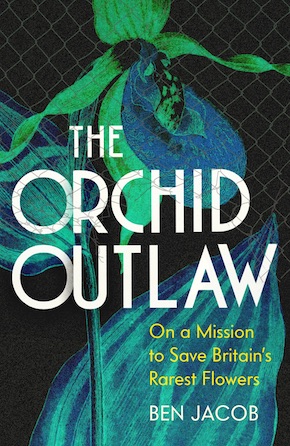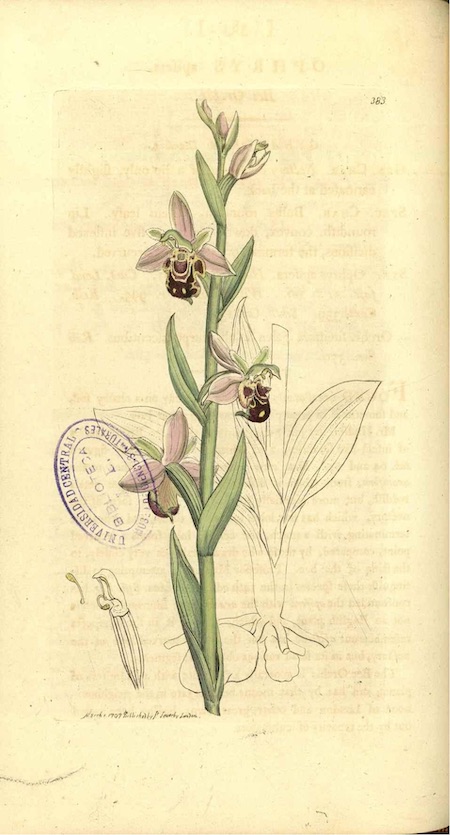Bees, Ghosts and breaking the law
by Ben Jacob
One June, in Devon, I encountered a few unusual small pink pennants in the long green grass of a meadow. They drew me in for a closer look. Clusters of these pennants were positioned along a tall stem. At the centre of each rested a bumble bee-sized brown velvet oval with yellow markings. An odd long thin, lime-green protuberance overhung the oval. From it dangled two small sun-yellow baubles like a pair of botanical dice hanging from a rear-view mirror. It was beautiful, unusual, astounding. Until that moment I hadn’t spared much thought for the greenery filling gardens and the gaps between cities, but those little flowers held me entranced. Inspired, I set out to learn more about them. That was how I discovered the plant was a Bee orchid. Before long it had changed my life and led me to break the law.
The word ‘orchid’ possesses an aura of exoticism and mystery dating from the Victorians’ passion for tropical species. During much of the nineteenth century they sent plant hunters around the world to wrench the most beautiful specimens they could find from native habitats to feed the hunger of wealthy European collectors. However, after encountering that Bee orchid I was surprised to learn that over fifty orchid species live right here in the not-so-exotic British Isles. Like that Bee they are just as beautiful and fascinating as their tropical cousins. In some ways they are even more so.
Our native orchids are pretty amazing. Some, like the Common Twayblade (not all British orchids are called ‘orchid’) can outlive humans by decades; others, like the Bee, evolved over millions of years to look, feel and even smell like female bees; some have metre-tall banners festooned with flowers like the writhing tails of reptiles, clouds of ladies in skirts, crowds of little people, pale angels, sleek alien wasps, yellow stars, startled mauve rabbits and leaping frogs – and that’s just a few. Their scents range from lily, clove, vanilla, musk, honey to… goat. Over timescales humans cannot comprehend these traits have emerged to aid their pollination. While most tropical orchids grow on tree branches or cliff faces, most British orchids grow in the earth a bit like daffodils or lily-of-the-valley from bulbs or rhizomes. For this ‘bulb’ to form the tiny seed of one of these orchids embarks on a process different from any other flowering plant. When the seed is washed into the earth it excretes a substance which controls fungi in the soil around it. This leads to threads of fungus growing into the seed. There they form coils which the germinating orchid embryo consumes. It is this fungal energy, not sunlight or water absorbed via roots, that allows the young orchid to develop. Some of Britain’s orchids, including the elusive, banana-scented Ghost orchid, which has upside-down-squid-looking flowers, have taken this relationship further: aside from occasionally pushing their flowers up into the sunlight, they live completely underground using fungal networks to tap into nutrients produced by nearby trees. No one (yet) quite knows how.
Existing where air, water and earth meet, our orchids are like canaries in the coalmine. Their decline is a warning we should all heed.”
Learning all this my view of the world changed. The orchid seed needs specific soil fungi, these fungi connect to other living elements in the earth in an interdependent series of relationships which humans, despite all our technology and intellect, don’t know much about. I became aware that leaves and flowers are just one visible element of a vast tapestry with roots extending into lightless oceans of complex life where unseen, mostly unknown, unnamed, uncountable and scarcely understood creatures (tardigrades, rotifers, proturans…) form earth and turn dead matter into the ingredients for life. Flowers connect to insect pollinators and seeds; seeds and insects to birds, leaves to insects and grazing animals, grazing animals and insects to us. Orchids had opened my eyes. Then I realised I was not so much learning about orchids as learning from them. Orchids had become my teachers – but these teachers were in peril.
Over the past century, Britain’s orchids have suffered rapid decline. In 1917, the graceful Lady’s Slipper with its sun-yellow pouch, claret hood and sepals, like twisting burgundy ponytails, was declared extinct. Thirteen years later, a single plant was discovered clinging to a remote Yorkshire hillside. To this day that lone plant remains under constant guard, tripwires alerting wardens of anyone approaching. Another orchid species, Irish Lady’s-tresses, with its seemingly plaited delicate white flowers, was last seen in England at a single spot on the edge of Dartmoor in 1993. Subsequently considered extinct in England and Wales, it was rediscovered twenty-six years later in north Wales. The Red Helleborine, with rose-pink flowers like birds in flight, once common across the Cotswolds, is now reduced to a few critically endangered plants kept in cages. The Ghost orchid, last seen in Britain in 2009 (after being declared extinct in 2005) might have gone forever. If so it has joined Summer Lady’s-tresses, the last British colony of which died out in 1952. It might take decades to know for sure whether the Ghost will ever appear in England again. During that time other species may join it for, sadly, over the past century, many British orchids have become among our fastest declining wildflowers.
The main causes of this loss include habitat destruction and habitat deterioration. Britain’s orchids adapted to exploit niches in coppiced woodland, managed hay meadows and marshes where sedge was harvested for thatch. These traditional forms of land management declined when the Industrial Revolution introduced a regime of large-scale commercial exploitation. This practice continues today. It marked a death knell for orchids and a host of other species adapted to sympathetically managed land and infertile, unpolluted earth. Mechanical ploughing, soil compaction by machinery, bigger and bigger livestock herds, dousing the land with biocides and other chemicals, the abandonment of the countryside by most people – let alone the effects of a rapidly changing climate – have devastating consequences for that interconnected tapestry of life which supports us, let alone orchids.
When I learned of the demise of those enchanting natives, I decided to do something about it. The government and construction industry talk a lot about sustainable construction and protecting biodiversity, but in this respect orchids and the rest of our native wildlife tell a story of failure. New developments routinely get the green light to turn pastures, woods and hedges into cement and brick. The laws meant to protect our wildlife excuse this destruction but punish anyone removing native plants without permission from that land – even to save them – with fines of £5,000 per uprooted plant or months in prison. For the sake of orchids, I decided to take that risk. After all, by then I felt that they had taught me so much I owed it to them to protect them. I found land which had been sold to developers, stole into those sites before bulldozers moved in, searched for orchids, dug out any that would be destroyed and replanted them somewhere safer. I chose to plant them in carefully selected spots in cities or towns because I wanted to bring Britain’s rare and fascinating flowers back to the human world where they might inspire others to find out more about them, their world and their plight.
When people hear about my unconventional methods of saving these plants – stealing into building sites, breaking the law and setting up a Breaking Bad-style lab in my kitchen to germinate their seeds – they ask, “Why do all this for orchids?” One reason is simple: existing where air, water and earth meet, our orchids are like canaries in the coalmine. Their decline is a warning we should all heed. If I can save some of them, I can save a bit of that tapestry which might otherwise disappear. Their disappearance is a sign that the threads of the world are unravelling. The thing is, we don’t need the law to change, or policymakers to reform their destructive systems: as I show in The Orchid Outlaw, for the sake of our children we can – we must – play a part in keeping that tapestry of life together.
—

Ben Jacob, a university lecturer by day and clandestine ecologist by night, lives with his family (and a small plantation of native orchids) at an undisclosed location deep in the West Country. The Orchid Outlaw, his first book, is published by John Murray in hardback, eBook and audio download.
Read more
@outlaworchid
Instagram: @orchid_outlaw
@johnmurrays



